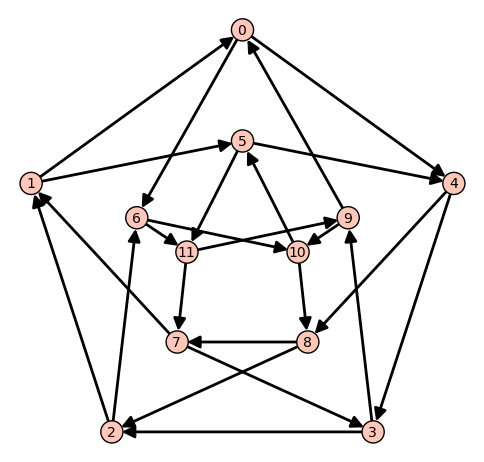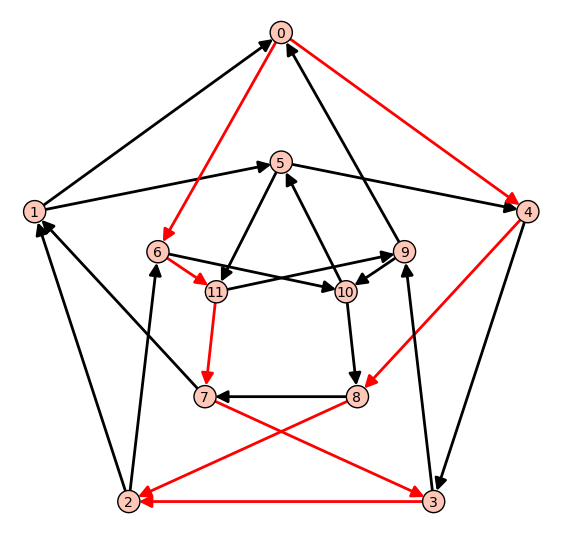This document explains the use of linear programming (LP) – and of mixed integer linear programming (MILP) – in Sage by illustrating it with several problems it can solve. Most of the examples given are motivated by graph-theoretic concerns, and should be understandable without any specific knowledge of this field. As a tool in Combinatorics, using linear programming amounts to understanding how to reformulate an optimization (or existence) problem through linear constraints.
This is a translation of a chapter from the book Calcul mathematique avec Sage.
Here we present the usual definition of what a linear program is: it is defined by a matrix \(A: \mathbb{R}^m \mapsto \mathbb{R}^n\), along with two vectors \(b,c \in \mathbb{R}^n\). Solving a linear program is searching for a vector \(x\) maximizing an objective function and satisfying a set of constraints, i.e.
where the ordering \(u \leq u'\) between two vectors means that the entries of \(u'\) are pairwise greater than the entries of \(u\). We also write:
Equivalently, we can also say that solving a linear program amounts to maximizing a linear function defined over a polytope (preimage or \(A^{-1} (\leq b)\)). These definitions, however, do not tell us how to use linear programming in combinatorics. In the following, we will show how to solve optimization problems like the Knapsack problem, the Maximum Matching problem, and a Flow problem.
There is a bad news coming along with this definition of linear programming: an LP can be solved in polynomial time. This is indeed a bad news, because this would mean that unless we define LP of exponential size, we can not expect LP to solve NP-complete problems, which would be a disappointment. On a brighter side, it becomes NP-complete to solve a linear program if we are allowed to specify constraints of a different kind: requiring that some variables be integers instead of real values. Such an LP is actually called a “mixed integer linear program” (some variables can be integers, some other reals). Hence, we can expect to find in the MILP framework a wide range of expressivity.
The MILP class in Sage represents a MILP! It is also used to solve regular LP. It has a very small number of methods, meant to define our set of constraints and variables, then to read the solution found by the solvers once computed. It is also possible to export a MILP defined with Sage to a .lp or .mps file, understood by most solvers.
Let us ask Sage to solve the following LP:
To achieve it, we need to define a corresponding MILP object, along with 3 variables x,y and z (which by default can only take non-negative values, see next section):
sage: p = MixedIntegerLinearProgram()
sage: x, y, z = p['x'], p['y'], p['z']
doctest:839: DeprecationWarning: The default behaviour of new_variable() will soon change ! It will return 'real' variables instead of nonnegative ones. Please be explicit and call new_variable(nonnegative=True) instead.
See http://trac.sagemath.org/15521 for details.
Next, we set the objective function
sage: p.set_objective(x + y + 3*z)
And finally we set the constraints
sage: p.add_constraint(x + 2*y <= 4)
sage: p.add_constraint(5*z - y <= 8)
The solve method returns by default the optimal value reached by the objective function
sage: round(p.solve(), 2)
8.8
We can read the optimal assignation found by the solver for \(x, y\) and \(z\) through the get_values method
sage: round(p.get_values(x), 2)
4.0
sage: round(p.get_values(y), 2)
0.0
sage: round(p.get_values(z), 2)
1.6
In the previous example, we obtained variables through p['x'], p['y'] and p['z'], which is a convenient shortcut when our LP is defined over a small number of variables. This being said, larger LP/MILP will require us to associate a LP variable to many Sage objects, which can be integers, strings, or even the vertices and edges of a graph. We use in this case an alternative syntax.
If we need 15 variables \(x_1, \dots, x_{15}\), we will first define a dictionary of variables with the new_variable method
sage: x = p.new_variable()
With this new object x we can now write constraints using x[1],...,x[15].
sage: p.add_constraint(x[1] + x[12] - x[14] >= 8)
Notice that we did not need to define the “length” of x. Actually, x would accept any immutable object as a key, as a dictionary would. We can now write
sage: p.add_constraint(x["I am a valid key"] +
....: x[("a",pi)] <= 3)
And because any immutable object can be used as a key, doubly indexed variables \(x^{1,1}, ..., x^{1,15}, x^{2,1}, ..., x^{15,15}\) can be referenced by x[1,1],...,x[1,15],x[2,1],...,x[15,15]
sage: p.add_constraint(x[3,2] + x[5] == 6)
By default, all the LP variables represent non-negative reals.
Types : If you want a variable to assume only integer or binary values, use the integer=True or binary=True arguments of the new_variable method. Alternatively, call the set_integer and set_binary methods.
Bounds : By default all variables represent non-negative reals. If you want a variable to represent arbitrary reals (or arbitrary integers), you should redefine its lower bound using the set_min method. If you want to set an upper bound on a variable, use the set_max method.
The Knapsack problem is the following: given a collection of items having both a weight and a usefulness, we would like to fill a bag whose capacity is constrained while maximizing the usefulness of the items contained in the bag (we will consider the sum of the items’ usefulness). For the purpose of this tutorial, we set the restriction that the bag can only carry a certain total weight.
To achieve this, we have to associate to each object \(o\) of our collection \(C\) a binary variable taken[o], set to 1 when the object is in the bag, and to 0 otherwise. We are trying to solve the following MILP
Using Sage, we will give to our items a random weight:
sage: C = 1
sage: L = ["pan", "book", "knife", "gourd", "flashlight"]
sage: L.extend(["random_stuff_" + str(i) for i in range(20)])
sage: weight = {}
sage: usefulness = {}
sage: set_random_seed(685474)
sage: for o in L:
... weight[o] = random()
... usefulness[o] = random()
We can now define the MILP itself
sage: p = MixedIntegerLinearProgram()
sage: taken = p.new_variable(binary=True)
sage: p.add_constraint(sum(weight[o] * taken[o] for o in L) <= C)
sage: p.set_objective(sum(usefulness[o] * taken[o] for o in L))
sage: p.solve() # abs tol 1e-6
3.1502766806530307
sage: taken = p.get_values(taken)
The solution found is (of course) admissible
sage: sum(weight[o] * taken[o] for o in L) # abs tol 1e-6
0.6964959796619171
Should we take a flashlight?
sage: taken["flashlight"]
1.0
Wise advice. Based on purely random considerations.
Given a graph \(G\), a matching is a set of pairwise disjoint edges. The empty set is a trivial matching. So we focus our attention on maximum matchings: we want to find in a graph a matching whose cardinality is maximal. Computing the maximum matching in a graph is a polynomial problem, which is a famous result of Edmonds. Edmonds’ algorithm is based on local improvements and the proof that a given matching is maximum if it cannot be improved. This algorithm is not the hardest to implement among those graph theory can offer, though this problem can be modeled with a very simple MILP.
To do it, we need – as previously – to associate a binary variable to each one of our objects: the edges of our graph (a value of 1 meaning that the corresponding edge is included in the maximum matching). Our constraint on the edges taken being that they are disjoint, it is enough to require that, \(x\) and \(y\) being two edges and \(m_x, m_y\) their associated variables, the inequality \(m_x + m_y \leq 1\) is satisfied, as we are sure that the two of them cannot both belong to the matching. Hence, we are able to write the MILP we want. However, the number of inequalities can be easily decreased by noticing that two edges cannot be taken simultaneously inside a matching if and only if they have a common endpoint \(v\). We can then require instead that at most one edge incident to \(v\) be taken inside the matching, which is a linear constraint. We will be solving:
Let us write the Sage code of this MILP:
sage: g = graphs.PetersenGraph()
sage: p = MixedIntegerLinearProgram()
sage: matching = p.new_variable(binary=True)
sage: p.set_objective(sum(matching[e] for e in g.edges(labels=False)))
sage: for v in g:
... p.add_constraint(sum(matching[e]
... for e in g.edges_incident(v, labels=False)) <= 1)
sage: p.solve()
5.0
sage: matching = p.get_values(matching)
sage: [e for e,b in matching.iteritems() if b == 1] # not tested
[(0, 1), (6, 9), (2, 7), (3, 4), (5, 8)]
Yet another fundamental algorithm in graph theory: maximum flow! It consists, given a directed graph and two vertices \(s, t\), in sending a maximum flow from \(s\) to \(t\) using the edges of \(G\), each of them having a maximal capacity.

The definition of this problem is almost its LP formulation. We are looking for real values associated to each edge, which would represent the intensity of flow going through them, under two types of constraints:
This being said, we have to maximize the amount of flow leaving \(s\): all of it will end up in \(t\), as the other vertices are sending just as much as they receive. We can model the flow problem with the following LP
We will solve the flow problem on an orientation of Chvatal’s graph, in which all the edges have a capacity of 1:
sage: g = graphs.ChvatalGraph()
sage: g = g.minimum_outdegree_orientation()
sage: p = MixedIntegerLinearProgram()
sage: f = p.new_variable()
sage: s, t = 0, 2
sage: for v in g:
... if v != s and v != t:
... p.add_constraint(
... sum(f[(v,u)] for u in g.neighbors_out(v))
... - sum(f[(u,v)] for u in g.neighbors_in(v)) == 0)
sage: for e in g.edges(labels=False):
... p.add_constraint(f[e] <= 1)
sage: p.set_objective(sum(f[(s,u)] for u in g.neighbors_out(s)))
sage: p.solve()
2.0

Sage solves linear programs by calling specific libraries. The following libraries are currently supported:
Provided under the open source license CPL, but incompatible with GPL. CBC can be installed through the command install_package("cbc").
Proprietary, but free for researchers and students.
Licensed under the GPLv3. This solver is installed by default with Sage.
Proprietary, but free for researchers and students.
PPL: A solver from bugSeng.
Licensed under the GPLv3. This solver provides exact (arbitrary precision) computation.
ILOG’s CPLEX and GUROBI being proprietary softwares, you must be in possession of several files to use it through Sage. In each case, the expected (it may change !) filename is joined.
The environment variable defining the licence’s path must also be set when running Sage. You can append to your .bashrc file one of the following :
For CPLEX
export ILOG_LICENSE_FILE=/path/to/the/license/ilog/ilm/access_1.ilmFor GUROBI
export GRB_LICENSE_FILE=/path/to/the/license/gurobi.lic
As Sage also needs the files library and header files the easiest way is to create symbolic links to these files in the appropriate directories:
libcplex.a – in SAGE_ROOT/local/lib/, type:
ln -s /path/to/lib/libcplex.a .
cplex.h – in SAGE_ROOT/local/include/, type:
ln -s /path/to/include/cplex.h .
cpxconst.h (if it exists) – in SAGE_ROOT/local/include/, type:
ln -s /path/to/include/cpxconst.h .
For GUROBI
libgurobi45.so – in SAGE_ROOT/local/lib/, type:
ln -s /path/to/lib/libgurobi45.so libgurobi.sogurobi_c.h – in SAGE_ROOT/local/include/, type:
ln -s /path/to/include/gurobi_c.h .
It is very important that the names of the symbolic links in Sage’s folders ** be precisely as indicated. If the names differ, Sage will not notice that** the files are present
Once this is done, Sage is to be asked to notice the changes by calling:
sage -b